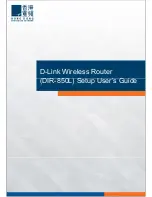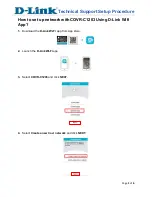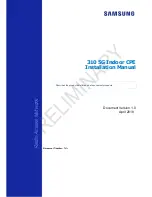
LOHU 2325L
User Manual
----------------------------------------------------------------------------------------------------------
-----------------------------------------------------------------------------------------------------------------------------------------------------------------------------------------------------------------
Voltlaan 408 – 2681 TV Monster – Netherlands
Tel : +31208080743
Email : [email protected]
Website : www.lohuisnetworks.com
International Numbers:
Dubai :
United States:
United Kingdom:
France :
Italy:
Japan:
Argentina:
Brazil :
Pakistan:
+97142280111
+12123812983
+442033557669
+33170612716
+390662207084
+81345506867
+541152391407
+552135219853
+92217019804
-
9
-
about protocols, but just forwards data depending on the destination address in the
data packet. This address is not the IP address, but the MAC (Media Access Control)
address that is unique to each network adapter card. With a Bridge, all your
computers are in the same network subnet, so you don't have to worry about not
being able to communicate between computers or share an Internet connection. The
only data that is allowed to cross the bridge is data that is being sent to a valid address
on the other side of the bridge.
Router
- Router is an OSI model Layer 3 device, and forwards data depending on the
network address, not the hardware (MAC) address. For TCP/IP networks this means the
IP address of the network interface. Routers isolate each LAN into a separate subnet.
Routers provide bandwidth control by keeping data out of subnets where it doesn't
belong, however routes need to be set up before they can get going.
NAT Router
– This mode is similar to the Router mode only that all traffic coming on
wired interface and going out on wireless interface is masqueraded. Masquerade allows
a set of machines to invisibly access the Internet via the gateway (Lohuis in this case).
To other machines on the Internet, all this outgoing traffic will appear to be from the
Lohuis device itself. In addition to the added functionality, IP Masquerade provides the
foundation to create a fairly secure networking environment.
DHCP
– Enable or disable built in DHCP client/server.
DHCP Relay
– In IP Router/NAT Router mode enable DHCP Relay so DHCP requests
coming from the LAN subnetwork will be relayed to the WLAN subnetwork and DHCP
Server replies will be relayed back to the LAN interface. If no specific DHCP server IP
address is configured (default value 0.0.0.0) then DHCP requests will be relayed to
any DHCP server on the WLAN address. If the DHCP server IP address is configured
then all DHCP requests will be relayed to that particular DHCP server.
Firewall
– Enable or disable built in packet filtering firewall.
PPPoE Authorization
– Enable or disable built in PPPoE client:
In IP Bridge mode, if PPPoE is enabled, the device will authorize itself to the
PPPoE concentrator and establish a PPP link to it. Ethernet traffic will be
bridged as usual.
In IP Router/NAT Router mode, if PPPoE is enabled, the Lohuis device will
authorize itself to the PPPoE concentrator and establish a PPP link to it – over
the wireless interface in the Access Point Client mode or over the wired interface
in the Access Point mode, PPPoE link will be then used as a default gateway by
the device. While operating in Router/Access Point Client all traffic originating
from the wired LAN subnetwork will be transported over PPPoE link to the
PPPoE concentrator.










































